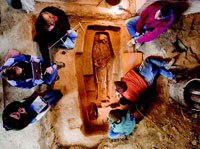Online Extras
-
Zoom in on 17thCentury Remains

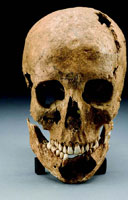
Chip Clark/Smithsonian
Skull of a fourteen- or fifteen-year-old boy, likely killed in 1607 by an Indian arrow at Jamestown.
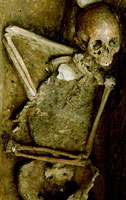
Chip Clark/Smithsonian
Skeleton of the “Arrow Point Boy,” hastily buried at Jamestown Fort in 1607. His bones tell of the hard, brief life for many settlers in Virginia.
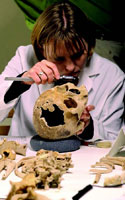
Chip Clark/Smithsonian
Forensic anthropologist Karin Bruwelheide measuring a colonial-era skull at the Smithsonian Institution’s Museum of Natural History.
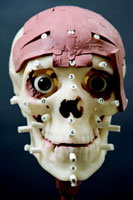
Chip Clark/Smithsonian
In preparatory work at a Smithsonian lab, numbered markers indicate the depth of tissues that a sculptor will add to the facial reconstruction of an early Jamestown settler.
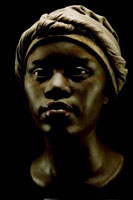
Chip Clark/Smithsonian
Based on the work of a forensic artist, a fully realized reconstruction of the bust of an African American woman whose remains were excavated in Talbot County, Maryland
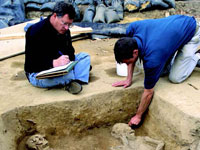
Chip Clark/Smithsonian
Doug Owsley takes notes on the excavation of a double burial found at Jamestown Fort.
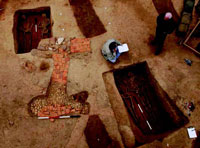
Michael Lavin/APVA Preservation Virginia
William Kelso observes as Doug Owsley takes notes on the excavation of a double burial found at Jamestown Fort.
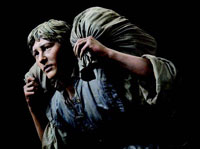
Chip Clark/Smithsonian
Life-size reconstruction of a boy found at Leavy Neck, Anne Arundel County, Maryland.
Dead Men Do
Tell Tales
by Gil Klein
In a laboratory hidden from the tourists who flock through the Smithsonian’s Museum of Natural History in Washington, DC, Doug Owsley examines a skull that is part of a skeleton unearthed in Virginia’s Gloucester County. The bones tell him the man spent his life in colonial Virginia. He was old, by colonial standards, when he died—perhaps fifty-five. The burial clues and bones say he was a person of means who had not been worn down by hard labor. But what struck Owsley as odd were the teeth. They were all there.
One doesn’t often see that in a colonial Virginian of means, he said. They liked their sweets, and the few who survived into old age usually lost their teeth.
No one knew this about that man since his death in about 1730 until Owsley and his staff examined his remains. It is one fact among thousands that are being compiled from the skeletons of early colonists in the Chesapeake Bay area. Taken together, they are painting a picture of early colonial life more detailed than the historical record or archaeological research can provide. For Owsley, who has spent a lifetime studying bones, dead men do tell tales.
On a table next to his desk is a facial reconstruction of Kennewick Man, built from a 9,000-year-old skull found in Washington State that Owsley believes will show that the earliest humans in North America did not all come across the Bering land bridge. The story the bones tell is more complex and interesting.
When a class of college students visited him, he had to caution them not to touch the bones carefully laid out on the surrounding tables. Some were part of active murder cases, and Owsley was conducting forensic investigations for local law enforcement.
In one laboratory, full skeletons of people who died during the nineteenth century lie on tables along with a box that contains a mummified forearm and hand, possibly of a Civil War soldier.
Owsley has studied human remains from the earliest North American inhabitants, through the sailors found entombed in the Confederate submarine Hunley, to the victims of the 1993 Branch Davidian raid in Waco, Texas, to determine who they were, how they lived, and why they died.
Since 1996, when the first skeleton was uncovered by archaeologist William Kelso at the site of James Fort, Owsley and his associate, Karin Bruwelheide, have concentrated on the bones of Chesapeake Bay’s colonists. They have compared them to bones found from the period in England, and have documented how the New World changed the lives of the settlers.
“The bones are not only going to tell you about the death of a person but also about the life of a person,” Owsley said. “We can see in the bones this whole process of becoming American.” Literally.
A bone can tell Owsley what a person ate, and by knowing what a person ate, Owsley can tell where the person lived for about a decade before to his or her death. How so?
A laboratory test known as stable isotope analysis can determine if the settler had a diet based primarily on wheat or corn. A person living in England existed on a wheat-based diet. An early Chesapeake Bay settler would quickly switch to a corn-based diet because corn was indigenous to the region and easier than wheat to grow in the climate of the Americas. The longer English settlers were in America, the more their bones registered the change from wheat to corn.
The bones also provide clues to the individual’s status. They can tell how much protein was in the diet: the more protein, the higher the person’s status. The amount of lead can be measured in a bone and also can indicate status. Higher-status people ate off pewter dishes, which in the colonial period contained lead. Low-status people ate off wooden bowls with wooden spoons. No lead.
Teeth can indicate from where a person came. Oxygen isotopes in the water a person drinks while growing up gets into tooth enamel. Oxygen isotope values in water change with latitude. That’s one way that Owsley can distinguish a skeleton of an immigrant from one of a person born in the Chesapeake.
A display in the Natural History Museum—“Written in Bone: Forensic Files of the Seventeenth-Century Chesapeake”—tells the story of Owsley and Bruwelheide’s research on Chesapeake Bay colonial life. It features skeletons unearthed in the Jamestown area and around St. Mary’s City, the original capital of Maryland that had all but disappeared before archaeology began there in the 1971. Findings from other, more obscure colonial sites in the Chesapeake also are included in the exhibit.
For Owsley, the bones tell an important story of individuals whose existence has been lost to the historical record. For example, little was written about Africans in the Chesapeake. Africans were rare in the earliest decades of the Jamestown settlement. The first twenty arrived in 1619 on a privateer that had captured a Portuguese slave ship headed for Mexico. By the 1660s the slave trade was established and individuals with African ancestry were living in the Virginia and Maryland colonies.
Skeletons from the seventeenth century are now being identified as African, and sometimes it is possible to tell which are first-generation slaves and from what region in Africa they may have come.
How? Teeth were sometimes filed in patterns that reflect specific African tribal customs. The practice did not continue in the Americas, but is preserved in the skeletal remains recovered from colonial period sites.
Every skeleton unearthed and brought to Owsley’s lab is studied and recorded. Age, sex, and ancestry. Dental pathology—how many teeth remained and what was their condition. Bone pathology—evidence of infections and arthritis, how many broken bones, how had they healed, how were they changed by labor. Each skeleton gets a physical description to determine height. Cranial measurements are taken, and ancestry is documented. Using advances in X-rays and computed tomography, Owsley uncovers facts that would not have been possible to know a few years ago.
Measurements are compared with those of bones from the eighteenth, nineteenth, and twentieth centuries to determine how people changed as America developed. “We are working toward a symposium at the Smithsonian in a few years that will bring together the results of all our skeletal research,” Owsley said.
But it’s the individual stories that Owsley and Bruwelheide find most fascinating, and some are featured in the “Written in Bone” exhibit. Take the mystery of a skeleton known as Arrow Point Boy.
Kelso discovered that James Fort had not washed away into the James River and started excavating. One of the first skeletons found was of a boy who Owsley determined from the bones and teeth was about fifteen years old and 5 foot 8 inches tall, large for the time. He was buried parallel to one of the fort’s walls near another similarly aligned grave. They are the only two in that location parallel to the fort wall.
This body had been interred in haste, seemingly with a lack of care. His arms were askew. By his right thigh bone just above his knee lay an arrowhead of the type made by the surrounding Powhatan Indians. This would have been embedded in the tissues of his leg at his burial. The boy’s collarbone was fractured. No doubt he died violently.
But his bones also showed that he led a difficult life, especially in the months before his death. The skeleton showed signs of an injury to his front teeth that fractured the crowns and exposed the tooth roots. This caused an unusually severe abscess. Infection had spread into the boy’s jaw, destroying the bone of the chin. If the Indian attack had not killed him, Owsley said, the infection likely would have.
“There is good evidence to show that he was one of the first people killed at Jamestown,” Bruwelheide said. From the record, she said, historians know the Indians attacked soon after the settlers arrived, that they killed a boy, and injured a man who died soon after. They were buried near one another.
“Who would have thought you could take an event recorded 400 years ago in a journal and today put all of the evidence together to retell the story?” she said. “Here was a teenager who came to Jamestown, and we now know something about him, how he died, and what role he played in our history. Here we can bring out stories with intimate details of people that give you a glimpse into history you can’t get from any other source.”
Anne Calvert was a high-status person. She and her husband, Philip Calvert, were buried under the church in St. Mary’s City in rare lead-clad coffins, which indicated they were people of wealth. Yet little is recorded about Anne, not even where she was buried.
Her bones told this story: She was more than sixty when she died in the late 1670s. She had lived in Maryland for quite a while. She had a healed leg fracture that abscessed until her death. She had severe osteoporosis. She did not eat a lot of meat protein, unlike most high-status people.
“What was her undoing was that she lived for a number of years with horrible teeth,” Owsley said. Many of Anne’s teeth had been lost in life to tooth decay and abscesses, and few upper and lower teeth met for effective chewing. She had lost her upper front teeth, and her lower teeth were worn to the root stubs. “It would have been hard for her to chew some foods, particularly meat. Of necessity she subsisted on softer foods, like porridge, but these were lower in protein. We can follow that in her bones through time.”
A high level of arsenic in her bones indicated she had access to medicines of her time, he said. But that did not help with her periodontal disease, which may have been caused by how she cleaned her teeth.
“High-status women would clean their teeth with a mildly acidic solution—dipping a cloth in vinegar with abrasives derived from ashed tobacco,” Owsley said. “They get so vigorous cleaning their teeth that they wear away the enamel, leading to abscesses.”
At the opposite end of the status spectrum was a body found in a cellar. The skeleton showed signs that it had been buried hastily under the house of a small planter in colonial Maryland. The family’s trash was found in the grave and piled over it.
Owsley determined it was a boy of sixteen or seventeen, about 5 feet 2 inches tall, and he had not yet reached his full growth. The bones told the story of hard physical labor. The muscle attachment areas on the boy’s shoulder bones and humeri showed he regularly carried heavy loads. His vertebrae were compressed from the weight. His bones indicated the early stages of an infection. His teeth were in such bad condition that the abscesses might have weakened his body.
This was most likely an indentured servant, a young man who signed a contract to come to America agreeing to work several years in return for the cost of his passage, Owsley said. The bones of this boy indicated his strength might have waned from disease. Unable to work, he probably was beaten to death by his master and hurriedly buried in the basement to hide the crime. Indentured servants made up more than a majority of early settlers in the Chesapeake Bay area, and they did the heavy labor before slavery became common.
Many died anonymously.
Mortality at a young age was high during the seventeenth century. This was especially true for the early James Fort settlers. In the winter of 1609–10, they endured a “starving time.” The skeletal record shows that of the eighty-three skeletons examined from a cemetery that served Jamestown from 1609 to 1630, most were between eighteen and twenty-five years old, Owsley said. Three were as old as thirty-five.
Across the bay in St. Mary’s City, life was a bit better for the first colonists. They learned from the Jamestown experience and were better prepared to cope with their new environment. Unlike Jamestown, which was a commercial venture first settled entirely by men, St. Mary’s started as a religious refuge for Catholics, and women were there from the beginning.
From the bones, Bruwelheide said, she can see how social structure and regional circumstances can change health and mortality. “The plight of the colonists isn’t the same everywhere,” she said. “One of the things we try to bring out is the difference among the individual stories.”
Jamestown archaeologist Kelso says Owsley’s research has been invaluable in filling out the lives of the colony’s settlers beyond what is in the historical record. He expects they will work closely as additional remains are uncovered. “I respect this man enormously—what he knows and how he shares his knowledge with us over the years,” Kelso said of Owsley. “He explains in common terms what he has found.”
For the Wyoming-born Owsley, his life since a professor at the University of Wyoming introduced him to forensic anthropology has been surrounded with skeletons and sometimes fresher human remains.
“It’s an opportunity to learn what their life was like,” he said as he surveyed the skeletons in his lab. “If you know where you came from, you are better prepared to face the future. There are messages here.”
He pauses a moment as he ponders a question on how dealing with so much death affects his life.
“I get a feeling of mortality,” he said. “Everything can end so quickly.”
Virginia-based journalist Gil Klein, former national correspondent for the Media General News Service in Washington, is a past president of the National Press Club, and is an American University assistant professor. He contributed to the summer 2012 journal a story about the use history makes of myths.
Suggestions for further reading:
- William Kelso, Jamestown: The Buried Truth (Charlottesville, VA, 2006).
- Douglas W. Owsley, Written in Bone: Bone Biographer’s Casebook (Minneapolis, 2009).
- Douglas E. Owsley and Sally M. Walker,Their Skeletons Speak (Minneapolis, 2012).
- Sally M. Walker, Written in Bone: Buried Lives of Jamestown and Colonial Maryland (Minneapolis, 2009).

